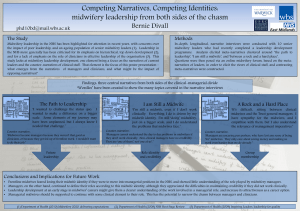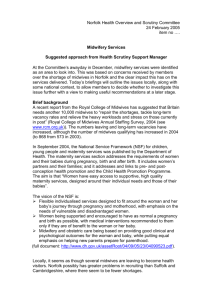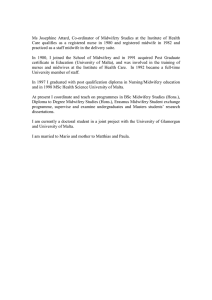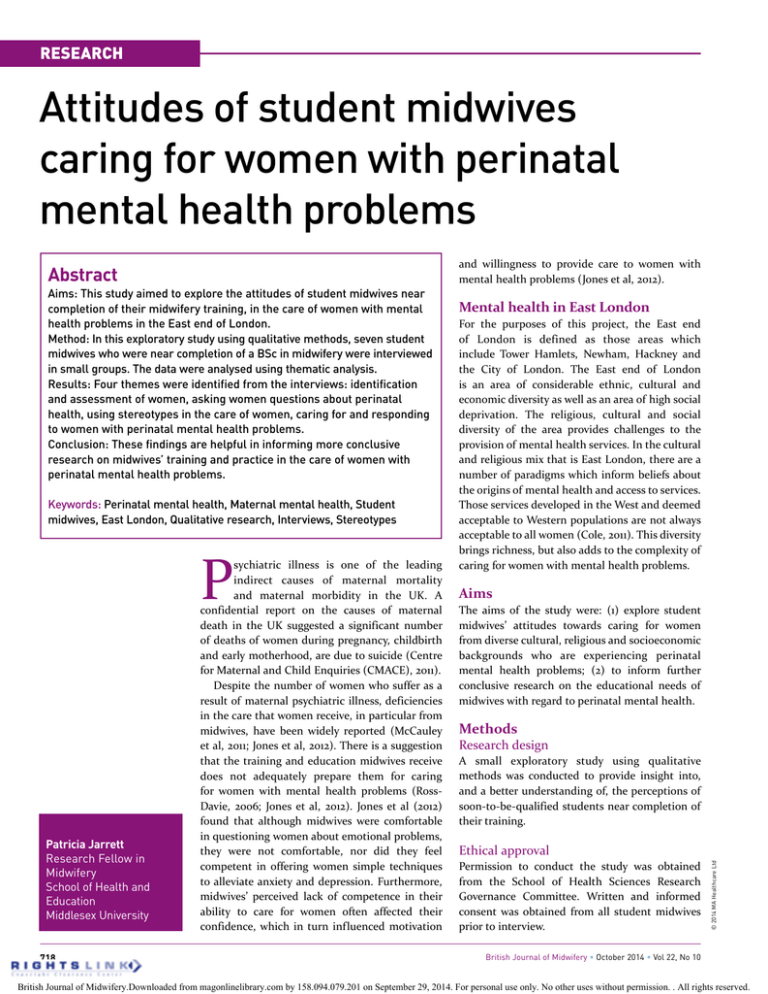
research
Attitudes of student midwives
caring for women with perinatal
mental health problems
and willingness to provide care to women with
mental health problems (Jones et al, 2012).
Aims: This study aimed to explore the attitudes of student midwives near
completion of their midwifery training, in the care of women with mental
health problems in the East end of London.
Method: In this exploratory study using qualitative methods, seven student
midwives who were near completion of a BSc in midwifery were interviewed
in small groups. The data were analysed using thematic analysis.
Results: Four themes were identified from the interviews: identification
and assessment of women, asking women questions about perinatal
health, using stereotypes in the care of women, caring for and responding
to women with perinatal mental health problems.
Conclusion: These findings are helpful in informing more conclusive
research on midwives’ training and practice in the care of women with
perinatal mental health problems.
Keywords: Perinatal mental health, Maternal mental health, Student
midwives, East London, Qualitative research, Interviews, Stereotypes
P
Patricia Jarrett
Research Fellow in
Midwifery
School of Health and
Education
Middlesex University
718
sychiatric illness is one of the leading
indirect causes of maternal mortality
and maternal morbidity in the UK. A
confidential report on the causes of maternal
death in the UK suggested a significant number
of deaths of women during pregnancy, childbirth
and early motherhood, are due to suicide (Centre
for Maternal and Child Enquiries (CMACE), 2011).
Despite the number of women who suffer as a
result of maternal psychiatric illness, deficiencies
in the care that women receive, in particular from
midwives, have been widely reported (McCauley
et al, 2011; Jones et al, 2012). There is a suggestion
that the training and education midwives receive
does not adequately prepare them for caring
for women with mental health problems (RossDavie, 2006; Jones et al, 2012). Jones et al (2012)
found that although midwives were comfortable
in questioning women about emotional problems,
they were not comfortable, nor did they feel
competent in offering women simple techniques
to alleviate anxiety and depression. Furthermore,
midwives’ perceived lack of competence in their
ability to care for women often affected their
confidence, which in turn influenced motivation
Mental health in East London
For the purposes of this project, the East end
of London is defined as those areas which
include Tower Hamlets, Newham, Hackney and
the City of London. The East end of London
is an area of considerable ethnic, cultural and
economic diversity as well as an area of high social
deprivation. The religious, cultural and social
diversity of the area provides challenges to the
provision of mental health services. In the cultural
and religious mix that is East London, there are a
number of paradigms which inform beliefs about
the origins of mental health and access to services.
Those services developed in the West and deemed
acceptable to Western populations are not always
acceptable to all women (Cole, 2011). This diversity
brings richness, but also adds to the complexity of
caring for women with mental health problems.
Aims
The aims of the study were: (1) explore student
midwives’ attitudes towards caring for women
from diverse cultural, religious and socioeconomic
backgrounds who are experiencing perinatal
mental health problems; (2) to inform further
conclusive research on the educational needs of
midwives with regard to perinatal mental health.
Methods
Research design
A small exploratory study using qualitative
methods was conducted to provide insight into,
and a better understanding of, the perceptions of
soon-to-be-qualified students near completion of
their training.
Ethical approval
Permission to conduct the study was
from the School of Health Sciences
Governance Committee. Written and
consent was obtained from all student
prior to interview.
obtained
Research
informed
midwives
© 2014 MA Healthcare Ltd
Abstract
British Journal of Midwifery • October 2014 • Vol 22, No 10
British Journal of Midwifery.Downloaded from magonlinelibrary.com by 158.094.079.201 on September 29, 2014. For personal use only. No other uses without permission. . All rights reserved.
research
Sampling strategy
Convenience sampling was used to recruit student
midwives to the study (Polit and Beck, 2009).
Student midwives were asked to participate in
this study as 60% of their training is spent in
clinical practice, placing them in a good position
to comment on standards of care.
Two groups of midwifery students, who were
approaching completion of a BSc in midwifery
programme, were invited to participate in the
study. One of the groups comprised students who
had no prior nurse training and were completing
a 3 year BSc in midwifery degree (n=36). The
second group comprised students who were
registered nurses and who were completing a
78-week or shortened BSc in midwifery degree
(n=24). Therefore the total number of students
invited to participate in the study was 60 (n=60).
Although both groups of students were invited to
attend the interviews, only those students who
were registered nurses and who were completing
the shortened BSc in midwifery programme
agreed. It was unclear why direct-entry students
opted not to attend for interview.
Information about the study was distributed via
email to students 4–6 weeks before the interviews
were due to be conducted. Students were given
the option of attending a small group interview
on one of 2 days. Interviews with students were
conducted in small groups comprising three and
four students.
Interviews
The interviews were conducted by the author and
a second member of the teaching staff. Both the
author and the second interviewer were directly
involved in the education of those students
participating in the study. The consequences of
using researchers who were closely involved with
teaching students, for example the affect this might
have on students’ responses, were recognised. In
order to minimise bias, students were reassured
that participation was voluntary, all information
was confidential and that there would be no
repercussions as a result of non-participation. The
interviews lasted between 55 minutes–1 hour 20
minutes and were digitally recorded.
© 2014 MA Healthcare Ltd
Questions used to generate discussion
The interviews were aimed to be an exploration of
student experiences and attitudes regarding caring
for women with mental health problems and were
intended to be as non-directional as possible. This
was in order to establish issues which students
themselves believed were pertinent to the care of
women with mental health problems.
British Journal of Midwifery • October 2014 • Vol 22, No 10
At the beginning of the interview, students were
asked ‘how do you experience caring for women
with mental health problems?’ Student responses
were further probed using questions such as ‘Can
you say a bit more about that?’, ‘How did that
make you feel?’, ‘What do you think should have
happened?’, ‘What would you have done, if you
had been in charge?’
Venue
The interviews were held in one of the teaching
rooms at a Medical Education Centre, in an East
London Hospital. This venue was chosen because
of its convenience for the majority of students.
Data analysis
The interviews were transcribed to produce a
verbatim account of students’ discussions (Braun
and Clarke, 2006). Thematic analysis was used
to analyse the data. Thematic analysis allows the
identification, analysis and reporting of patterns
or themes within data and minimally organises
and describes data in rich detail (Braun and Clarke,
2006). Initially, ‘units’ of data were identified from
the transcripts, which were then collated into an
initial set of codes. The codes were then grouped
into themes and sub-themes in light of how they
related to the aims of the research. Analysis of the
data was facilitated using NVivo version 9.
Seven student midwives out of a total of 60
agreed to participate in the study. Although many
students indicated an interest in participating in
the study at the onset, several students
subsequently failed to attend for interview
and therefore their views were not included in
this study. As discussed earlier, the reasons for
non-participation of students was unclear. At the
beginning of the interview, students were asked to
state if they had any prior training in mental health,
psychology or psychiatry before commencing the
BSc in midwifery programme. All participating
students were female and were completing a
shortened BSc in midwifery programme.
Results
Four themes were identified from the interviews:
ll Identification and assessment of women
ll Asking women questions about perinatal health
ll Using stereotypes in the care of women
ll Caring for and responding to women with
perinatal mental health problems.
Identification and assessment of women
Students often used informal or common sense
knowledge in their identification of women’s
mental health status. For example, a woman’s
719
British Journal of Midwifery.Downloaded from magonlinelibrary.com by 158.094.079.201 on September 29, 2014. For personal use only. No other uses without permission. . All rights reserved.
research
‘I could see that it must have been
stressful for her...she had a newborn
living in a place where she couldn’t
really keep warm. There were boxes
everywhere. There was dirt on the floor
and to me, she wasn’t coping. I just
thought she didn’t look like she was
coping.’ (Student midwife A)
Attitude, appearance, behaviour and body
language of women were also considered good
indicators of mental wellbeing. As such, eye
contact, response to questions and behaviour
towards the infant were used in the assessment of
a woman’s mood.
‘when you ask that question and she
doesn’t give eye contact...or she finds
it difficult to answer. In fact she might
even wait for about a few minutes
before...and you might even have to
ask her again...and the way that she’s
interacting with her baby...not bothering
if the baby’s crying…that would ring
alarm bells.’ (Student midwife B)
Students often used intuitive responses or ‘gut
feelings’ in their assessment of women.
‘and it didn’t match up with what was
going on...There was something out of
the ordinary with what was happening,
and her behaviour. I thought this
doesn’t look right... I just felt so uneasy
with it and I thought there’s got to be
something more.’ (Student midwife G)
Asking women questions about perinatal
mental health
Students, for the most part, were opposed to the
use of standardised questionnaires and screening
tools in assessing women’s mental health,
believing they were not effective. It was felt that
questions using the words ‘anxiety’ or ‘depression’
alienated women and prevented them disclosing
their symptoms. Students believed using simple
everyday language such as ‘feeling down’ was more
effective in stimulating open discussion.
‘Most midwives say “have you had
depression?”, “have you had anxiety?”,
720
“have you had schizophrenia?” and
actually those questions are quite
harsh...They should make it very simple
“Have you been crying?”, “Have you felt
down after the baby?” “Did you feel like
getting out of bed?” “Did you feel like
doing anything yesterday?”’ (Student
midwife B)
Students were critical of the way they saw
questionnaires being used by qualified staff.
The ‘tick box’ approach that students observed
qualified midwives using, did not always offer the
opportunity to explore women’s emotional issues
in any detail.
‘But what you will find though is some of
the midwives ask the question...They’ll
[women] answer the question, find out,
‘yes, they’re [experiencing problems]’...
and that’s it!...refer them!....but there’s
no more exploration with the woman
to find out a bit more about their
condition. It’s OK, it’s diagnosed, you’re
taking medication. Oh, that’s fine.’
(Student midwife B)
‘They [qualified midwives] say, “so
have you ever had any mental health
[problems]?” Then tick the box...I think
you’re not going to get the answers
from the women, the honest answers.’
(Student midwife A)
Using stereotypes in the care of women
One of the most important findings from the
current study was the assumptions students
made about women, based on cultural and illness
stereotypes. Students believed that cultural
background often dictated a woman’s response to
mental health, especially with regards to disclosure
of mental health issues and acceptability of
treatment options. For example, students believed
that Black Caribbean women did not acknowledge
their symptoms as depression.
‘I think most Caribbean women don’t
acknowledge that they have depression...
it’s not something [they] talk about.’
(Student midwife A)
Students held similar beliefs about Orthodox
Jewish women.
‘I think in some cultures it’s something
that they don’t talk about...it’s not an
© 2014 MA Healthcare Ltd
environment could provide clues she was
experiencing emotional or psychological problems
and was not coping well with the transition to
motherhood.
British Journal of Midwifery • October 2014 • Vol 22, No 10
British Journal of Midwifery.Downloaded from magonlinelibrary.com by 158.094.079.201 on September 29, 2014. For personal use only. No other uses without permission. . All rights reserved.
research
acknowledged thing. You’re meant to
have big families and lots of children
so it’s [depression] not a thing that
would be acknowledged if you’re not
feeling [emotionally well], and whenever
I’ve asked a Jewish woman how they
are postnatally they’re always “fine”.’
(Student midwife E)
In some cultures there was an expectation that
a woman’s role was primarily to marry and have
children. Students believed that it was difficult,
therefore, for women to express ambivalence
or unhappiness about marriage, pregnancy or
motherhood. Women who did not conform to
normal expectations were under enormous strain
and this affected their mental health.
‘...it’s their duty to have babies.’
(Student midwife A)
‘Like the Chinese lady who didn’t want
to have this [pregnancy] and the family
wanted her to have it...how do you turn
round and say, “Well, no, I didn’t want
this baby”?’ (Student midwife C)
‘They feel guilty if they are low...
they think that it’s not right [to feel
depressed or low] because they are
supposed to be happy.’ (Student
midwife B)
Caring for and responding to women with
perinatal mental health problems
There was considerable concern from one student
in relation to women with serious mental health
problems being offered assistant conception
treatment (ACP) or infertility treatment. One
student believed women with serious mental
health problems were unable to parent effectively
and thus students implied, were less deserving of
ACP than other women.
© 2014 MA Healthcare Ltd
‘…how can she have an IVF pregnancy
with this condition?...how on earth are
you going to cope with a baby?’ (Student
midwife B)
‘...and I couldn’t for the life of me
understand how a doctor could
give somebody...how can you just
give somebody IVF just like that?
Suppose one day she was to go and
have breakdown…and hurt her twins’
(Student midwife B)
British Journal of Midwifery • October 2014 • Vol 22, No 10
‘…there are so many people out there
that can’t have kids, that can’t have the
IVF treatment that would make good
parents…’ (Student midwife B)
Students reported feeling frightened by women with
serious mental health problems and admitted that
they did not always know how to respond, especially
if a woman was displaying aggressive behaviour.
‘I’m just scared that maybe with this
kind of women, you can say the wrong
thing…it was very scary because she was
quite aggressive…I felt I didn’t say the
correct thing because I don’t know how
to…’ (Student midwife F)
Additionally, the behaviour of women was
sometimes seen as premeditated and deviant.
‘…but it was just the way she was
carrying on…she hit one of the perinatal
team…I know I shouldn’t judge, but
I just felt that she’d been given this
opportunity and look how she’s carrying
on and it just didn’t feel fair…’ (Student
midwife B)
Discussion
This small exploratory study provided some insights
into the attitudes and experiences of student
midwives in their care of women living in East
London and who are experiencing mental health
problems. The findings from this study are not
intended to be conclusive; however, they do help
inform further exploratory research on midwifery
education and training with regard to perinatal
mental health with complex and diverse populations.
Screening and assessing women for
perinatal mental health problems
There were several examples where students
referred to the adverse social circumstances
experienced by women as indicative of poor mental
health. For example, one student suggested a ‘cold
and messy’ environment indicating social adversity
suggested women weren’t coping. Although
socioeconomic status has been recognised as a
risk factor for postnatal depression (CMACE,
2011) and poverty and deprivation contribute
to mental illness and mental distress (Lewis et
al, 1998), cleanliness and home environment
are often down to personal preferences and not
always good indicators of a woman’s mood. Other
factors are recognised as important in predicting
a woman’s risk of developing mental health
721
British Journal of Midwifery.Downloaded from magonlinelibrary.com by 158.094.079.201 on September 29, 2014. For personal use only. No other uses without permission. . All rights reserved.
ISTOCK PHOTO
research
and look for solutions (Vik et al, 2009). Despite
students concerns about using questionnaires,
there is overwhelming evidence to suggest that
used correctly screening tools reduce the risk of
undetected cases (Buist et al, 2006). Students in
the current study, however, failed to recognise this.
Psychiatric illness is one of the leading causes of maternal mortality and morbidity
in the UK
problems, however, students made little reference
to these. For example, lack of social support,
marital relationship difficulties and previous life
events are often considered stronger risk factors in
estimating the risk of postnatal depression than
socioeconomic status (Robertson et al, 2004).
Further, a confidential enquiry into the deaths of
women due to pregnancy and childbirth found
that women who commit suicide are often ‘middle
class, employed and in a supportive relationship’
(CMACE, 2011: 141). It would be difficult, therefore,
to assume that a woman’s risk of developing mental
health problems should be based exclusively on
her social and home environment.
One of the students interviewed preferred to
use more intuitive methods when identifying
a woman’s risk of developing mental health
problems and disliked using screening tools.
Students also recognised that women disliked a
‘tick box approach’. Although the sensitivity of
students to the needs of women was commendable,
there is considerable evidence as to the benefits
of using screening tools in the identification of
perinatal mental health problems in women (Buist
et al, 2002; Milgrom et al, 2011; Protopopescu
et al, 2012). Many women who commit suicide
as a result of pregnancy or childbirth have had
a previous psychiatric disorder which has gone
undetected (CMACE, 2011). Although women
do find re-telling distressing experiences during
depression screening uncomfortable (Rollans et
al, 2013), without the use of appropriate and
validated screening tools it is difficult to correctly
assess maternal mental wellbeing and conduct
a risk assessment. Additionally, screening tools
can help initiate a difficult conversation with a
woman about mental health issues, and can open
up communication and enable both the health
professional and woman to explore her responses
722
One of the most important findings from the
interviews concerned assumptions made by
students, based on culture and illness stereotypes,
largely regarding the causes of women’s mental
health problems. Although commendable that
cultural and religious differences were recognised
as potential contributing factors to a woman’s
vulnerability to mental health problems, these
links were sometimes communicated by students
in a superficial manner. There was often little
consideration of the other factors, for example,
economic disadvantage or hardship commonly
found in ethnic minority groups, and which
feasibly could have contributed to women’s
depression. Additionally, the use of stereotypes
by health professionals to explain illness has been
highlighted by others (Burr, 2002; Neale and Wand,
2013). In a study of South Asian women, Burr
(2002) found that negative stereotypes of cultural
difference were used by health professionals to
explain the cause of mental distress and that often
where an individual’s mental health problems were
attributed to cultural difference, the real causes of
illness were missed (Fenton and Sadiq-Sangster,
1996; Burr, 2002).
Other beliefs held by some students were
that women from some cultural and religious
groups did not always acknowledge mental health
problems or recognise the symptoms they were
experiencing as depression. The notion that
psychosomatic illness is not recognised or given
expression to by individuals in certain cultural
and religious groups has also been explored in
the literature. Fenton and Sadiq-Sangster (1996)
found that individuals from diverse cultures may
use different terms and language to explain their
symptoms of mental distress. For example, the
symptoms experienced by individuals often do
not coincide with a medicalised construction
of depression or mental illness nor how this
experience may be treated. That is, non-Western
populations do not experience, express, or treat
mental distress in the same way as those in the
West. Fenton and Sadiq-Sangster (1996) also
found that South Asian women had a specific
set of language terms to describe their mood.
Women did not use the term ‘depression’, instead
they used expressions such as ‘thinking too much
© 2014 MA Healthcare Ltd
Using social and illness stereotypes
British Journal of Midwifery • October 2014 • Vol 22, No 10
British Journal of Midwifery.Downloaded from magonlinelibrary.com by 158.094.079.201 on September 29, 2014. For personal use only. No other uses without permission. . All rights reserved.
research
in my heart’ and ‘thinking illness’ to describe
their distress (Fenton and Sadiq-Sangster, 1996:
75). As a result, women’s concept of mental
health, made it difficult for them to communicate
their experiences to health providers.
Similarly, Black Caribbean women’s expression
of mental health problems has been explored
extensively (Edge, 2008). Black Caribbean women
are often unfamiliar with the concept of depression
and unable to identify feelings and behaviours that
might be described as ‘depressive symptoms’ (Edge
2008: 384). Women may be unable to communicate
their feelings to health professionals in a way that
can be easily understood and subsequently may
not be offered treatment.
Other assumptions about women from cultural
minority groups were women’s lack of desire for
pregnancy and motherhood. Two students in
the current study often believed women from
ethnic minority groups were unhappy with being
pregnant and becoming mothers, were powerless
to express their unhappiness, and unable to assert
themselves against the wishes of their partners
or families. There is sometimes a presumption
that if only women were to adopt a more Western
lifestyle, their symptoms of depression would
resolve. However, women from Western societies
also experience high levels of mental distress,
both within, and independent of, repressive
relationships (Burr, 2002). It is difficult to support
the notion therefore, that depression alone
can be attributed to patriarchal and repressive
relationships or as a result of cultural background.
© 2014 MA Healthcare Ltd
Discrimination of women with mental
health problems
There was a suggestion that women with mental
health problems may be less deserving of being
parents and receiving infertility treatment,
than other women. Some students expressed
reservations about women with mental health
problems being able to manage the demands of
pregnancy and motherhood. These assumptions
were often made without reference to a woman’s
individual circumstances or further explanation.
In addition to this, one student midwife appeared
insecure in her interactions with women with serious
mental health problems and reported being scared
of saying the wrong thing and of being frightened
when caring for such women. There was a sense
that women who were experiencing these problems
could be unpredictable, violent or aggressive despite
the lack of evidence to support these perceptions
(Stuart and Arboleda-Florez, 2001).
The findings from this current project, in tandem
with other studies, suggest midwives often feel
British Journal of Midwifery • October 2014 • Vol 22, No 10
uncomfortable and unsafe in providing care for
women with mental health problems (Mivsek et al,
2008; Jones et al, 2012) and the care of such women is
‘out of their scope of practice’ (McCauley et al, 2011:
793). In their study, McCauley et al (2011) also found
that midwives avoided those women in their care
experiencing mental illness (McCauley et al, 2011).
Other studies report negative attitudes directed
at parents with disabilities, including those with
mental health problems, with regards their ability
to care for their children (Barber, 2008; WalshGallagher et al, 2012). Students in the current study
believed that women with mental health problems
tended to be violent and aggressive toward their
children. This was despite evidence to suggest that
with support, the majority of parents with mental
health problems are able to successfully care for
their children (Montgomery, 2005; O’Connor, 2012).
Women with serious mental health problems often
benefit from becoming mothers’ with motherhood
often representing the one legitimate role they have
in society (Mowbray et al, 1995).
Limitations
There were a number of limitations in carrying
out this study. This was a small exploratory study
exploring the attitudes of student midwives in
caring for women with mental health problems.
To begin, the interviews were conducted only with
those students who were qualified nurses and were
completing a shortened, 78 week, BSc in midwifery
programme. Including other students, for example
those students completing 3 year, direct-entry BSc
in midwifery programmes, might have produced
different experiences and perspectives and made
an additional contribution to the interviews.
Additionally, including midwifery students
from other institutions, who had undertaken an
alternative emphasis in their training, might have
provided further insight.
This study suggests there are gaps in the
knowledge and practice of soon-to-be-qualified
midwives towards women with emotional and
psychological needs during pregnancy and the
postpartum period.
Conclusion
These findings from this small exploratory
qualitative study have identified some attitudes
held by soon-to-be-qualified student midwives,
in caring for women with perinatal mental health
problems in a diverse population. The findings
of this study indicate students use cultural and
illness stereotypes in their identification and
provision of care of women with perinatal mental
health problems. Students were often critical
723
British Journal of Midwifery.Downloaded from magonlinelibrary.com by 158.094.079.201 on September 29, 2014. For personal use only. No other uses without permission. . All rights reserved.
of evidence-based practice or neglected to use
evidence in their care of women with mental
health problems. This study has implications for
the training of students and in preparing them
for clinical practice. A better understanding of
the complexity of mental health issues and the
importance of evidence-based knowledge among
student midwives is needed, especially when
caring for diverse groups. In addition, students
need a better understanding of the risk factors,
which predispose to the development of mental
health problems in pregnancy and require training
and support in using appropriate screening tools
BJM
in the identification of women.
Acknowledgement: The author would like to thank The
Florence Nightingale Foundation and The London Network
for Nurses and Midwives Partnership, Research Scholarship
2011-2012, for their financial support in funding this project.
Barber G (2008) Supporting pregnant women with
disabilities. Practice Nursing 19(7): 330–4
Braun V, Clarke V (2006) Using thematic analysis in
psychology. Qual Res Psychol 3(2): 77–101
Burr J (2002) Cultural stereotypes of women from South
Asian communities: mental health care professionals’
explanations for patterns of suicide and depression. Soc
Sci Med 55(5): 835–45
Buist AE, Barnett BE, Milgrom J, Pope S, Condon JT, Ellwood
DA, Boyce PM, Austin MP, Hayes BA (2002) To screen or
not to screen – that is the question in perinatal depression.
Med J Aust 177(Suppl): S101–5
Buist A, Bilszta J, Milgrom J, Barnett B, Hayes B, Austin MP
(2006) Health professional’s knowledge and awareness of
perinatal depression: Results of a national survey. Women
Birth 19(1): 11–6
Centre for Maternal and Child Enquiries (2011) Saving
Mothers’ Lives: reviewing maternal deaths to make
motherhood safer: 2006–08. The Eighth Report on
Confidential Enquiries into Maternal Deaths in the United
Kingdom. BJOG 118(Suppl 1): 1–203
Cole K (2011) Mental Health in East London and the City A
Sector-Level Health Needs Assessment. http://tinyurl.com/
pd6urcp (accessed 9 September 2014)
Edge D (2008) ‘We don’t see Black women here’: an
exploration of the absence of Black Caribbean women
Key points
ll Psychiatric illness is one of the leading causes of maternal mortality
and morbidity in the UK
ll Adverse socio-economic factors and ethnic diversity can add to the
complexity of caring for women with perinatal mental health problems
ll Interviews with soon-to-be-qualified midwives indicate use of tacit
knowledge and intuitive responses predominate in students’ decision
making and care of women with perinatal health problems
ll Students often neglect to use current research and appeared
unconvinced of the value of evidence in the care of women with
perinatal mental health problems
724
from clinical and epidemiological data on perinatal
depression in the UK. Midwifery 24(4): 379–89
Fenton S, Sadiq-Sangster A (1996) Culture, relativism and
the expression of mental distress: South Asian women in
Britain. Sociology of Health and Illness 18(1): 66–85.
Jones CJ, Creedy DK, Gamble JA (2012) Australian midwives
attitudes towards care for women with emotional distress.
Midwifery 28(2): 216-221. doi: 10.1016/j.midw.2010.12.008
Lewis G, Bebbington P, Brugha T, Farrell M, Gill B, Jenkins R,
Meltzer H (1998) Socioeconomic status, standard of living,
and neurotic disorder. Lancet 352(9128): 605–9
McCauley K, Elsom S, Muir-Cochrane E, Lyneham J (2011)
Midwives and assessment of perinatal mental health
problems. J Psychiatr Ment Health Nurs 18(9): 786–95
Milgrom J, Mendelsohn J, Gemmill AW (2011) Does postnatal
depression screening work? Throwing out the bathwater,
keeping the baby. J Affect Disord 132(3): 301–10. doi:
10.1016/j.jad.2010.09.031article/pii/S0165032710006129
Mivsek A, Hundley V, Kiger A (2008) Slovenian midwives’
and nurses’ views on post-natal depression: an exploratory
study. International Nursing Review 55(3): 320–6
Montgomery P (2005) Mothers with a serious mental illness:
A critical review of the literature. Arch Psychiatr Nurs
19(5): 226–35
Mowbray C, Oyserman D, Ross SR (1995) Parenting and the
significance of children for women with a serious mental
illness. Journal of Mental Health Administration 22(2):
189–200. doi.org/10.1007/BF02518758
Neale A, Wand A (2013) Issues in the evaluation and
treatment of anxiety and depression in migrant women in
the perinatal period. Australasian Psychiatry 21(4): 379–82
O’Connor S (2012) Child neglect and child abuse. In: Martin
CM (Ed) Perinatal Mental Health: A clinical Guide. M&K
Publishing, Keswick, Cumbria
Polit DF, Beck CT (2009) Essentials of Nursing Research:
Appraising Evidence for Nursing Practice. (7th edn)
Lippincott Williams and Wilkins, MD, USA
Protopopescu X, Austin M-P, Reilly N, Barnett B (2012)
Screening and psychosocial assessment. In: Martin CM
(Ed) Perinatal Mental Health: A clinical Guide. M&K
Publishing, Keswick, Cumbria
Robertson E, Grace S, Wallington T, Stewart DE (2004)
Antenatal risk factors for postpartum depression: a
synthesis of recent literature. Gen Hosp Psychiatry 26(4):
289–95
Rollans M, Schmeid V, Kemp L, Meade T (2013) Digging over
that old ground: an Australian perspective of women’s
experience of psychological assessment and depression
screening in pregnancy and following birth. BMC Womens
Health 13: 18. doi: 10.1186/1472-6874-13-18
Ross-Davie M, Green L, Sakar A, Elliot S (2006) A public
health role in perinatal mental health: are midwives ready?
British Journal of Midwifery 14(6): 330-335
Stuart HL, Arboleda-Florez JE (2001) A public health
perspective on violent offenses among persons with
mental illness. Psychiatric Services 52(5): 654–9
Vik K, Aass IM, Willumsen AB, Hafting M (2009) It’s about
focusing on the mother’s mental health: Screening
for postnatal depression seen from the health visitors’
perspective. Scand J Public Health 37(3): 239–45
Walsh-Gallagher D, Sinclair M, Mc Conkey R(2012) The
ambiguity of disabled women’s experiences of pregnancy.
Childbirth and motherhood: A phenomenological
understanding. Midwifery 28(2): 156–62
© 2014 MA Healthcare Ltd
research
British Journal of Midwifery • October 2014 • Vol 22, No 10
British Journal of Midwifery.Downloaded from magonlinelibrary.com by 158.094.079.201 on September 29, 2014. For personal use only. No other uses without permission. . All rights reserved.

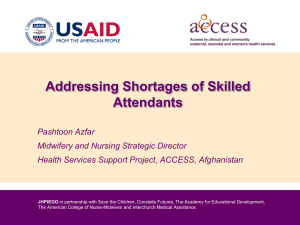
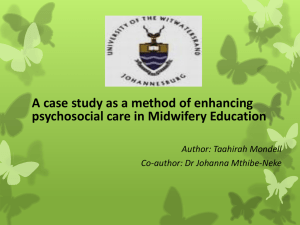
![Letter to MPs re: maternal mental health report Dear [Name of MP] I](http://s3.studylib.net/store/data/006839335_1-7d7b3127aade7ad6d126565942ce75c1-300x300.png)
